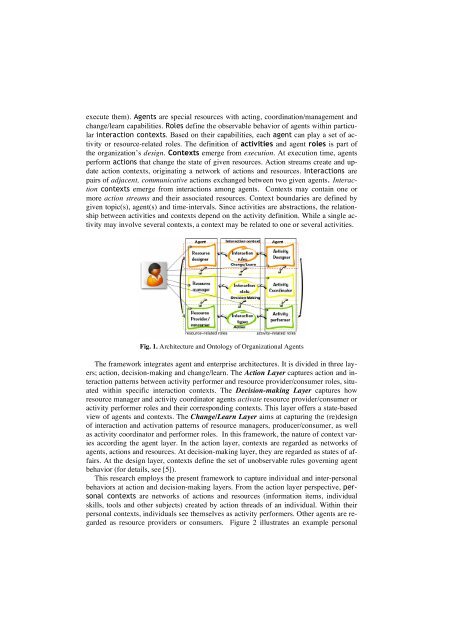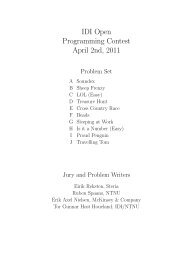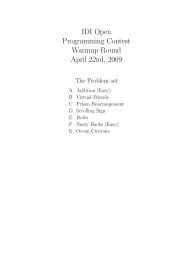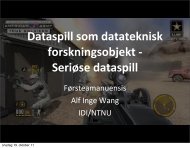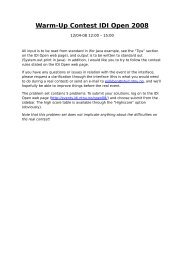Reverse-engineering of individual and inter-personal work practices
Reverse-engineering of individual and inter-personal work practices
Reverse-engineering of individual and inter-personal work practices
- No tags were found...
You also want an ePaper? Increase the reach of your titles
YUMPU automatically turns print PDFs into web optimized ePapers that Google loves.
execute them). Agents are special resources with acting, coordination/management <strong>and</strong>change/learn capabilities. Roles define the observable behavior <strong>of</strong> agents within particular<strong>inter</strong>action contexts. Based on their capabilities, each agent can play a set <strong>of</strong> activityor resource-related roles. The definition <strong>of</strong> activities <strong>and</strong> agent roles is part <strong>of</strong>the organization’s design. Contexts emerge from execution. At execution time, agentsperform actions that change the state <strong>of</strong> given resources. Action streams create <strong>and</strong> updateaction contexts, originating a net<strong>work</strong> <strong>of</strong> actions <strong>and</strong> resources. Interactions arepairs <strong>of</strong> adjacent, communicative actions exchanged between two given agents. Interactioncontexts emerge from <strong>inter</strong>actions among agents. Contexts may contain one ormore action streams <strong>and</strong> their associated resources. Context boundaries are defined bygiven topic(s), agent(s) <strong>and</strong> time-<strong>inter</strong>vals. Since activities are abstractions, the relationshipbetween activities <strong>and</strong> contexts depend on the activity definition. While a single activitymay involve several contexts, a context may be related to one or several activities.Fig. 1. Architecture <strong>and</strong> Ontology <strong>of</strong> Organizational AgentsThe frame<strong>work</strong> integrates agent <strong>and</strong> enterprise architectures. It is divided in three layers;action, decision-making <strong>and</strong> change/learn. The Action Layer captures action <strong>and</strong> <strong>inter</strong>actionpatterns between activity performer <strong>and</strong> resource provider/consumer roles, situatedwithin specific <strong>inter</strong>action contexts. The Decision-making Layer captures howresource manager <strong>and</strong> activity coordinator agents activate resource provider/consumer oractivity performer roles <strong>and</strong> their corresponding contexts. This layer <strong>of</strong>fers a state-basedview <strong>of</strong> agents <strong>and</strong> contexts. The Change/Learn Layer aims at capturing the (re)design<strong>of</strong> <strong>inter</strong>action <strong>and</strong> activation patterns <strong>of</strong> resource managers, producer/consumer, as wellas activity coordinator <strong>and</strong> performer roles. In this frame<strong>work</strong>, the nature <strong>of</strong> context variesaccording the agent layer. In the action layer, contexts are regarded as net<strong>work</strong>s <strong>of</strong>agents, actions <strong>and</strong> resources. At decision-making layer, they are regarded as states <strong>of</strong> affairs.At the design layer, contexts define the set <strong>of</strong> unobservable rules governing agentbehavior (for details, see [5]).This research employs the present frame<strong>work</strong> to capture <strong>individual</strong> <strong>and</strong> <strong>inter</strong>-<strong>personal</strong>behaviors at action <strong>and</strong> decision-making layers. From the action layer perspective, <strong>personal</strong>contexts are net<strong>work</strong>s <strong>of</strong> actions <strong>and</strong> resources (information items, <strong>individual</strong>skills, tools <strong>and</strong> other subjects) created by action threads <strong>of</strong> an <strong>individual</strong>. Within their<strong>personal</strong> contexts, <strong>individual</strong>s see themselves as activity performers. Other agents are regardedas resource providers or consumers. Figure 2 illustrates an example <strong>personal</strong>


